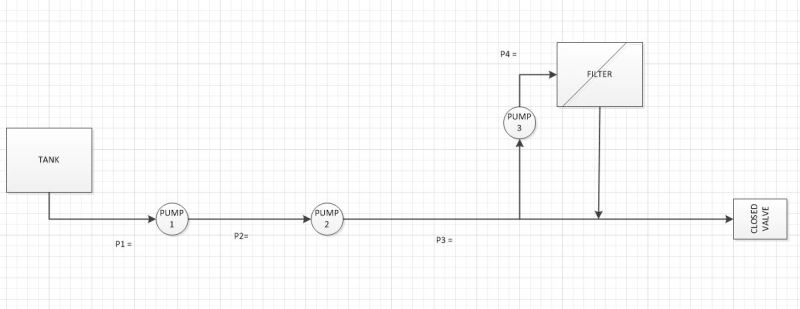I have two pumps operating in series to achieve a higher overall discharge pressure. If a valve on the discharge line is closed, both pumps will deadhead. My question is whether the net pressure in the piping downstream of the pumps (upstream of valve obviously) will be the sum of the deadhead pressure of the two pumps or only the deadhead pressure of the higher pressure pump? Why?
Navigation
Install the app
How to install the app on iOS
Follow along with the video below to see how to install our site as a web app on your home screen.
Note: This feature may not be available in some browsers.
More options
Style variation
-
Congratulations MintJulep on being selected by the Eng-Tips community for having the most helpful posts in the forums last week. Way to Go!
You are using an out of date browser. It may not display this or other websites correctly.
You should upgrade or use an alternative browser.
You should upgrade or use an alternative browser.
Total Deadhead Pressure of Pumps Operating in Series
- Thread starter 092961
- Start date
- Status
- Not open for further replies.
LittleInch
Petroleum
Assuming these are centrifugal pumps then it is the sum of the differential shut in heads plus the head of the inlet to the first pump at no flow. Can be a lot more than you see in operation.
Why? Because the pumps are adding differential head to the fluid so what head enters the second pump is the discharge head of the first pump.
Any details or background here??
Remember - More details = better answers
Also: If you get a response it's polite to respond to it.
Why? Because the pumps are adding differential head to the fluid so what head enters the second pump is the discharge head of the first pump.
Any details or background here??
Remember - More details = better answers
Also: If you get a response it's polite to respond to it.
yousif aldossary
Mechanical
good day dear
the pressure will be =pump1 + pump2 + downstream ( it could be a tank head ) , and the reason is becuase because in this case you are dealing with closed system , which every thing will add up .
to proove this theory check the downstream PSV set preasure and you will find out that it will be equal to all of the dead head pressures of all related equipments and vessels .
regards
the pressure will be =pump1 + pump2 + downstream ( it could be a tank head ) , and the reason is becuase because in this case you are dealing with closed system , which every thing will add up .
to proove this theory check the downstream PSV set preasure and you will find out that it will be equal to all of the dead head pressures of all related equipments and vessels .
regards
- Thread starter
- #4
Pumps are centrifugal. Feed is tank ~8-ft head. Line is 6" pipe. In a closed space, no flow, pressure should all be equal so what you're saying is the entire line is the sum of all pump heads at zero flow plus the 3.5-psi static pressure at suction to first pump? I've (very roughly) drawn the scenario:


yousif aldossary
Mechanical
good day
as for the calculation :
1/ pumps pressure shall be found in performance curve at zero flow.
2/ tank pressure shall be calculated by density*head*9.81 , lines sizes can be neglected.( note that suction nozzle is almost 1 meter from the ground if you need very conservative calculation you shall subtract it from total head , depending on the pump suction level from the ground)
regards
as for the calculation :
1/ pumps pressure shall be found in performance curve at zero flow.
2/ tank pressure shall be calculated by density*head*9.81 , lines sizes can be neglected.( note that suction nozzle is almost 1 meter from the ground if you need very conservative calculation you shall subtract it from total head , depending on the pump suction level from the ground)
regards
LittleInch
Petroleum
P3 will be, p4 is P3 + pump 3, but this seems to be on a loop so there will be flow all the time. Don't get the P3 + filter bit though.
Remember - More details = better answers
Also: If you get a response it's polite to respond to it.
Remember - More details = better answers
Also: If you get a response it's polite to respond to it.
yousif aldossary
Mechanical
good day
thanks littleinch for the remark , actually i didnt notice above process diagram .
any way yes as you said , and even for more precise calculation the filter manufacturer should give approximate value for the filter discharge factor or the filter minimum head loss , and subtract it from the total pressure .
after you try this calculation try to check any close by downstream PSV and check its set point to clarify .
regards
thanks littleinch for the remark , actually i didnt notice above process diagram .
any way yes as you said , and even for more precise calculation the filter manufacturer should give approximate value for the filter discharge factor or the filter minimum head loss , and subtract it from the total pressure .
after you try this calculation try to check any close by downstream PSV and check its set point to clarify .
regards
- Status
- Not open for further replies.
Similar threads
- Question
- Replies
- 12
- Views
- 15K
- Question
- Replies
- 5
- Views
- 8K
- Replies
- 7
- Views
- 846
- Question
- Replies
- 4
- Views
- 14K
